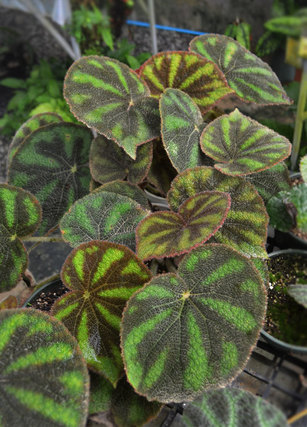
These are tropical begonias and are foliage type -- they typically have stunning foliage and make great additions to one's plant collection. If you admire foliage as much as flowers, then you will understand this attraction.
We focus on species and would say many of these are not "Average Begonia" -- while many growers might think of Begonias as care-free windowsill plants, or even as outdoor annuals! Begonia actually a vast and varied family. They contain many species and types, not all of which require the same care. Several of our selection are plants that need more attention to humidity and moisture. Oftentimes, terrarium or greenhouse care is necessary. Some example species included here are: Begonia chloroneura, Begonia polilloensis, Begonia rajah, Begonia smithiae and so many others.
These and so many other similar species & hybrids are best accommodated in humid greenhouses or in terrariums. Growing under artificial lights is also a common arrangement that allows for easier temperature management. In addition, some Begonias can also be of a tuberous type. Those of this nature, such as Begonia pteridiformis, Begonia integrifolia and Begonia curtisii do best is a seasonal dry and coolish rest is provided - typically during the dry season.
Curious to know about recommended media? This varies depending upon the container and watering practices. In general, try to use very couarse, porous media. What we choose in our nursery is a mixture of peat, perlite, vermiculite and chopped sphagnum. A ratio of the above that works for us is roughly - 3:3:1:3 Actually the ratio of all these ingredients can vary depending sometimes upon the plant itself as well as whether it is to be grown in a closed terrarium or in an open greenhouse. For those known to grow natively in Limestone regions, particularly Chinese and Vietnamese native species, we also add a small percentage of Limestone powder to the mix. Whatever media is used, remember that a healthy well-developed root system is paramount to good growth of the plant. If you are not seeing good root activity, then something is off and needs adjustment.
During the spring-summer months, or as long as the plants appear to be actively growing, to ensure they receive adequate and sufficient supply of nutrients. this is best provided via a good quality, complete (with micro nutrients & trace elements), fertilizer. Do keep in mind that the warmer the weather and brighter the light they are receiving, may dictate the frequency of the feeding needed.
We focus on species and would say many of these are not "Average Begonia" -- while many growers might think of Begonias as care-free windowsill plants, or even as outdoor annuals! Begonia actually a vast and varied family. They contain many species and types, not all of which require the same care. Several of our selection are plants that need more attention to humidity and moisture. Oftentimes, terrarium or greenhouse care is necessary. Some example species included here are: Begonia chloroneura, Begonia polilloensis, Begonia rajah, Begonia smithiae and so many others.
These and so many other similar species & hybrids are best accommodated in humid greenhouses or in terrariums. Growing under artificial lights is also a common arrangement that allows for easier temperature management. In addition, some Begonias can also be of a tuberous type. Those of this nature, such as Begonia pteridiformis, Begonia integrifolia and Begonia curtisii do best is a seasonal dry and coolish rest is provided - typically during the dry season.
Curious to know about recommended media? This varies depending upon the container and watering practices. In general, try to use very couarse, porous media. What we choose in our nursery is a mixture of peat, perlite, vermiculite and chopped sphagnum. A ratio of the above that works for us is roughly - 3:3:1:3 Actually the ratio of all these ingredients can vary depending sometimes upon the plant itself as well as whether it is to be grown in a closed terrarium or in an open greenhouse. For those known to grow natively in Limestone regions, particularly Chinese and Vietnamese native species, we also add a small percentage of Limestone powder to the mix. Whatever media is used, remember that a healthy well-developed root system is paramount to good growth of the plant. If you are not seeing good root activity, then something is off and needs adjustment.
During the spring-summer months, or as long as the plants appear to be actively growing, to ensure they receive adequate and sufficient supply of nutrients. this is best provided via a good quality, complete (with micro nutrients & trace elements), fertilizer. Do keep in mind that the warmer the weather and brighter the light they are receiving, may dictate the frequency of the feeding needed.
By click on each image, it will direct you to an individual item description, showing more information, including offered size and price.
OUR SHOPPING CART SYSTEM IS STILL NOT ENABLED. PLEASE PLACE AN ORDER USING DOMESTIC OR INTERNATIONAL ORDER FORM WE APOLOGIZE FOR INCONVENIENCE.
OUR SHOPPING CART SYSTEM IS STILL NOT ENABLED. PLEASE PLACE AN ORDER USING DOMESTIC OR INTERNATIONAL ORDER FORM WE APOLOGIZE FOR INCONVENIENCE.